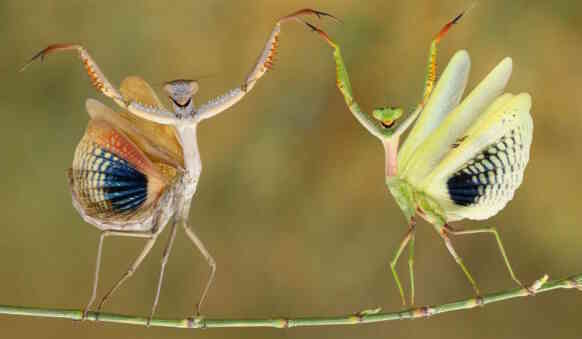Praying Mantises — fairly ancient insects. They gained fame thanks to their unusual appearance and completely fearless disposition — a hungry praying mantis will attack without hesitation any enemy it can defeat and eat, while avoiding collisions that can become fatal for it.
Interesting facts about praying mantises
- Mantises — the only insects whose head rotates in different directions in the same way as a person.
- They feed mainly on small insects, but on occasion they can also bite a lizard, a frog or even a small snake. Mantis spiked forelimbs — a terrible weapon.
- The largest mantises reach a height of 10-12 centimeters.
- The praying mantis is able to eat and digest almost anything without harm to itself. These insects attack like a black widow — deadly poisonous spider, and ladybugs, which are themselves very toxic.
- The female praying mantis often kills and eats the male after mating. By the way, this also happens with scorpions (interesting facts about scorpions).
- There are more than two thousand species of praying mantises in the world.
- The ancient Egyptians worshiped praying mantises and even mummified them like pharaohs.
- In some countries of Central Asia, people in the countryside keep praying mantises to kill insect pests (interesting facts about insects).
- Mantises — masters of disguise, and their colors always match the main color scheme of the area in which they live.
- Cannibalism among these insects — Not unusual. Two hungry males will most likely attack each other, and the winner will eat the loser.
- Mantises prefer to eat their victims alive. They will not eat dead prey, even if they are starving.
- Female praying mantises are always larger than males, and therefore they cannot fly — wings are weak. And males may well fly from branch to branch.
- A characteristic pose in which praying mantises are most often photographed (forelimbs raised up) — a signal that the insect is ready to attack.
- The eggs laid by the female praying mantis are so well protected that they are not afraid of either frost or toxic chemicals.
- None of the species of praying mantis is dangerous for humans, but if you make him angry, he can bite hard — it will hurt.
